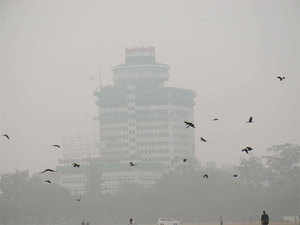Killer smog: How much can India learn to fight pollution from China?
ET Online|
Nov 13, 2017, 02.56 PM IST

China has been more successful than India in fighting pollution. According to a Greenpeace analysis of NASA’s satellite data on particulate matter in India and China, the levels of fine particulate matter rose across India by 13% between 2010 and 2015 while they fell by 17% in China in the same period. Delhi’s average annual PM 2.5 concentrations are more than double those in Beijing
What did China do?
China moved early to control pollution, especially after the 2008 Beijing Olympics which put a spotlight on smog. China cracked down on polluting vehicles and factories to improve the air for the games. Even though these temporary measures did not offer a long-term solution, the war on pollution had begun in China.
China revised its laws to impose severe restrictions on polluting factories. The local authorities can even detain owners of factories that fail to comply with the laws. They can also impose heavy fines on such factories. In India, laws are less strict and implementation is random.
China has also cracked down on coal-fired power plants. The Chinese government shut down nearly 100 such plants a few months ago. It has cut steel production capacity by 50 million tons. New plants have to meet strict emission criteria. China's huge investment in alternative and renewable energy such as wind and solar is also targeted at decreasing pollution.
Not only has China produces automobile fuel that complies with the Euro V standards, it has restricted car ownership too. In Beijing, one person cannot buy the second car in his own name. It is also an early mover in electric mobility while India has just set an ambitious target to have only electric cars by 2030.
More awareness of pollution among the masses coupled with extensive monitoring by the government also helps fight pollution in China. According to a 2016 Greenpeace report, China has a network of 1500 air-quality monitoring stations across more than 900 cities. India has only 39 such stations across 23 cities.
Can't India too take such steps?
While China moved early to control pollution, India is a bit late. Today, India has yet to provide jobs to millions of its youths and 24x7 electricity to every household. These two aims can discourage a crackdown on coal-based power plants and polluting factories.
While India's aim to have only electric cars by 2030 is laudable, little has been done on restricting ownership and use of polluting vehicles in big cities except for the order by the National Green Tribunal to ban old diesel vehicles.
Unlike the authoritarian China, where law-making as well enforcement can be quick, a democratic India is slow on these counts. Composite solutions such as the need for Delhi, Punjab and Haryana to work jointly on smog get mired in raucous politics.
India's crackdown on industrial pollution at this stage can jeopardise employment and economic growth. The GDP growth is already sliding and the country faces a jobs crisis. Though there have been studies that link an increase in GDP growth to improvement in environment, the immediate impact of heavy restrictions on industry might backfire.
India must find solutions that suit its own circumstances. Even the Chinese agree all of their methods can't work in India. "Air pollution has become a common challenge for both China and India. Beijing has its own way to cope with it. New Delhi needs to find its method soon," says Chinese state-run media outlet Global Times.
What did China do?
China moved early to control pollution, especially after the 2008 Beijing Olympics which put a spotlight on smog. China cracked down on polluting vehicles and factories to improve the air for the games. Even though these temporary measures did not offer a long-term solution, the war on pollution had begun in China.
China revised its laws to impose severe restrictions on polluting factories. The local authorities can even detain owners of factories that fail to comply with the laws. They can also impose heavy fines on such factories. In India, laws are less strict and implementation is random.
China has also cracked down on coal-fired power plants. The Chinese government shut down nearly 100 such plants a few months ago. It has cut steel production capacity by 50 million tons. New plants have to meet strict emission criteria. China's huge investment in alternative and renewable energy such as wind and solar is also targeted at decreasing pollution.
Not only has China produces automobile fuel that complies with the Euro V standards, it has restricted car ownership too. In Beijing, one person cannot buy the second car in his own name. It is also an early mover in electric mobility while India has just set an ambitious target to have only electric cars by 2030.
More awareness of pollution among the masses coupled with extensive monitoring by the government also helps fight pollution in China. According to a 2016 Greenpeace report, China has a network of 1500 air-quality monitoring stations across more than 900 cities. India has only 39 such stations across 23 cities.
Can't India too take such steps?
While China moved early to control pollution, India is a bit late. Today, India has yet to provide jobs to millions of its youths and 24x7 electricity to every household. These two aims can discourage a crackdown on coal-based power plants and polluting factories.
While India's aim to have only electric cars by 2030 is laudable, little has been done on restricting ownership and use of polluting vehicles in big cities except for the order by the National Green Tribunal to ban old diesel vehicles.
Unlike the authoritarian China, where law-making as well enforcement can be quick, a democratic India is slow on these counts. Composite solutions such as the need for Delhi, Punjab and Haryana to work jointly on smog get mired in raucous politics.
India's crackdown on industrial pollution at this stage can jeopardise employment and economic growth. The GDP growth is already sliding and the country faces a jobs crisis. Though there have been studies that link an increase in GDP growth to improvement in environment, the immediate impact of heavy restrictions on industry might backfire.
India must find solutions that suit its own circumstances. Even the Chinese agree all of their methods can't work in India. "Air pollution has become a common challenge for both China and India. Beijing has its own way to cope with it. New Delhi needs to find its method soon," says Chinese state-run media outlet Global Times.







